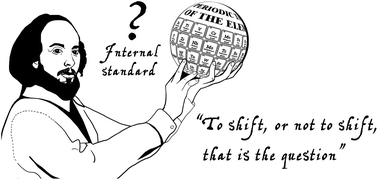To shift, or not to shift: adequate selection of an internal standard in mass-shift approaches using tandem ICP-mass spectrometry (ICP-MS/MS)†
Abstract
The use of an internal standard to correct for potential matrix effects and instrument instability is common practice in ICP-MS. However, with the introduction of a new generation of ICP-MS instrumentation with a tandem mass spectrometry configuration (ICP-MS/MS), the use of chemical resolution in a mass-shift approach has become much more popular, suggesting that the appropriate selection of an internal standard needs revision. In this particular case, it needs to be decided whether the internal standard should also be subjected to a mass-shift or can simply be monitored on-mass (“to shift, or not to shift”). In this work, 17 elements covering a wide range of masses (24–205 amu) and ionization energies (3.89–9.39 eV) were measured via on-mass and/or mass-shift strategies, and the corresponding atomic ions and reaction product ions were monitored during various systematic experiments. For mass-shifting, an NH3/He gas mixture was used to obtain NH3-based reaction product ions (cluster formation). Product ion scanning (PIS) was used for assessing the differences in reactivity between the different analytes and for the identification of the best suited reaction product ions. It was found that the use of chemical resolution can significantly affect the short-term signal stability and that ion signals measured on-mass are not affected in the same way as those measured mass-shifted. Variations affecting the signal intensities of both atomic and reaction product ions can be attributed to the ion–molecule chemistry occurring within the collision/reaction cell and were found to be related with some degree of initial instability in the cell and differences in reactivity. The use of a sufficiently long stabilization time, however, avoids or at least mitigates such differences in the behavior between signals monitored on-mass and after mass-shifting, respectively. Furthermore, the introduction of cell disturbances, such as those generated after quickly switching between different sets of operating conditions in a multi-tune method, revealed significant differences in signal behavior between atomic and reaction product ions, potentially hampering the use of an internal standard monitored on-mass when the analysis is based on an analyte monitored after mass-shifting. However, the use of a reasonable waiting time again greatly mitigates such differences, with the duration of this stabilization time depending on the magnitude of the cell disturbances (e.g., switch between vented and pressurized mode or only between pressurized modes using different gas flow rates). In addition, also the effect of varying different instrument settings (plasma power, torch position, and gas and liquid flow rates) was evaluated, but no remarkable differences were found between signals monitored on-mass and those mass-shifted. Interestingly, a statistical evaluation of the influence of the different settings on the signal intensities of all ions monitored did not reveal the a priori important role of some properties traditionally suggested for adequate selection of analyte/internal standard pairs, such as mass number or ionization energy, as also suggested in other recent studies.



 Please wait while we load your content...
Please wait while we load your content...